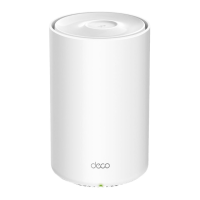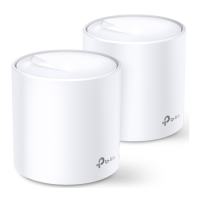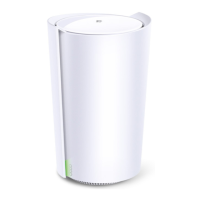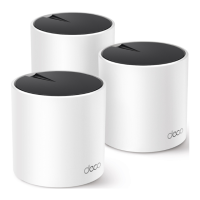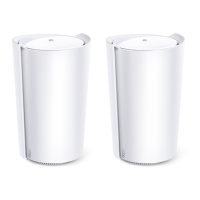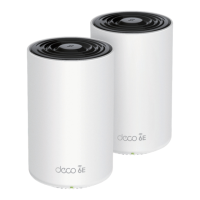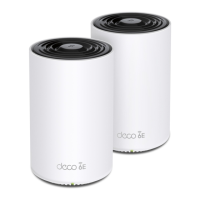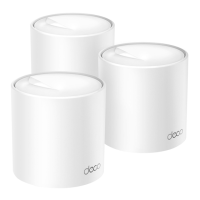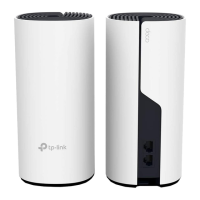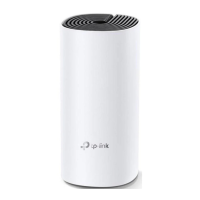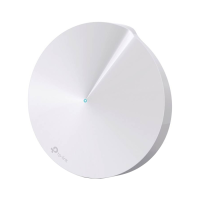Do you have a question about the TP-Link Deco X20 and is the answer not in the manual?
Explains the conventions used in the guide for clarity.
Provides various disclaimers regarding features, availability, and performance.
Explains LED colors and their meanings for device status.
Describes the Ethernet ports, power slot, and reset button.
Guides on downloading and installing the Deco mobile application.
Instructions for logging in and selecting the Deco model.
Steps for connecting the Deco to the modem and setting up internet.
Steps to set up the Wi-Fi network name and password.
Shows how to view the network status and clients.
Guides on creating shortcuts and automations for smart actions.
Explains access to HomeShield security features.
Shows how to start the process of adding new Decos to the network.
Guides on selecting the model and following setup instructions.
How to view the online/offline status of all Decos.
Viewing speed, IP, MAC, and connected clients for each Deco.
Starting the process to change the main Deco unit.
Choosing a satellite Deco to become the new main unit.
Starting the process to remove or reboot a Deco.
Choosing the specific Deco and the action (remove/reboot).
Viewing detailed information for connected devices.
How to rename a connected device for easier identification.
Setting up automated actions and high priority for devices.
Accessing detailed device settings like IP, MAC, and Mesh.
Steps to create custom locations for organizing devices.
How to see devices organized by their assigned locations.
Steps to create a new network via the Overview page.
Steps to create a new network via the main menu.
Navigating to the option to change the network owner.
Providing new owner details and confirming the change.
Starting the network deletion process from the Overview page.
Selecting the delete option and confirming the action.
Navigating to the section for adding smart devices.
Following app instructions to add smart devices to the network.
Steps to create a shortcut for smart actions.
Defining the action and selecting the device for the shortcut.
Configuring action duration, delay, and naming the shortcut.
Initiating the automation creation process.
Defining conditions and actions for automation.
Selecting devices and setting specific parameters for triggers/actions.
Naming the automation and confirming completion.
Information about HomeShield features and benefits.
Details on Scan, Real-Time Protection, and Parental Controls.
Changing Wi-Fi name, password, and hiding the network.
Options for sharing Wi-Fi network access.
Steps to activate and set up a guest network.
Methods for sharing guest network credentials.
Preventing devices from accessing the network.
Steps to remove devices from the blocked list.
Navigating to the firmware update section in the app.
Process for updating the Deco firmware.
Managing IPv4 and IPv6 internet connection types.
Configuring IPv6 firewall rules and LAN IP settings.
Enabling IPTV/VLAN mode and MAC Clone feature.
Setting up DDNS and SIP ALG for network services.
Enabling UPNP, Fast Roaming, and Beamforming.
Changing operation mode and setting connection alerts.
Starting the WPS connection process from the app.
Connecting a client device using WPS.
Inviting friends and family to help manage the network.
Defining access levels for network managers.
Guides on setting up voice control with Amazon Alexa.
Examples of voice commands for managing the Deco network.
Solutions for common setup and connection problems.
Resolving internet loss and Deco app operational problems.
Details FCC compliance and statement for the device.
Information on RF exposure limits and compliance.
States compliance with relevant EU directives.
Details EU RF exposure requirements and national usage limits.
Declares compliance with UK regulations.
Compliance statement for Industry Canada.
Specifies operating and storage temperature/humidity.
Explains symbols and provides recycling information.
Explains the conventions used in the guide for clarity.
Provides various disclaimers regarding features, availability, and performance.
Explains LED colors and their meanings for device status.
Describes the Ethernet ports, power slot, and reset button.
Guides on downloading and installing the Deco mobile application.
Instructions for logging in and selecting the Deco model.
Steps for connecting the Deco to the modem and setting up internet.
Steps to set up the Wi-Fi network name and password.
Shows how to view the network status and clients.
Guides on creating shortcuts and automations for smart actions.
Explains access to HomeShield security features.
Shows how to start the process of adding new Decos to the network.
Guides on selecting the model and following setup instructions.
How to view the online/offline status of all Decos.
Viewing speed, IP, MAC, and connected clients for each Deco.
Starting the process to change the main Deco unit.
Choosing a satellite Deco to become the new main unit.
Starting the process to remove or reboot a Deco.
Choosing the specific Deco and the action (remove/reboot).
Viewing detailed information for connected devices.
How to rename a connected device for easier identification.
Setting up automated actions and high priority for devices.
Accessing detailed device settings like IP, MAC, and Mesh.
Steps to create custom locations for organizing devices.
How to see devices organized by their assigned locations.
Steps to create a new network via the Overview page.
Steps to create a new network via the main menu.
Navigating to the option to change the network owner.
Providing new owner details and confirming the change.
Starting the network deletion process from the Overview page.
Selecting the delete option and confirming the action.
Navigating to the section for adding smart devices.
Following app instructions to add smart devices to the network.
Steps to create a shortcut for smart actions.
Defining the action and selecting the device for the shortcut.
Configuring action duration, delay, and naming the shortcut.
Initiating the automation creation process.
Defining conditions and actions for automation.
Selecting devices and setting specific parameters for triggers/actions.
Naming the automation and confirming completion.
Information about HomeShield features and benefits.
Details on Scan, Real-Time Protection, and Parental Controls.
Changing Wi-Fi name, password, and hiding the network.
Options for sharing Wi-Fi network access.
Steps to activate and set up a guest network.
Methods for sharing guest network credentials.
Preventing devices from accessing the network.
Steps to remove devices from the blocked list.
Navigating to the firmware update section in the app.
Process for updating the Deco firmware.
Managing IPv4 and IPv6 internet connection types.
Configuring IPv6 firewall rules and LAN IP settings.
Enabling IPTV/VLAN mode and MAC Clone feature.
Setting up DDNS and SIP ALG for network services.
Enabling UPNP, Fast Roaming, and Beamforming.
Changing operation mode and setting connection alerts.
Starting the WPS connection process from the app.
Connecting a client device using WPS.
Inviting friends and family to help manage the network.
Defining access levels for network managers.
Guides on setting up voice control with Amazon Alexa.
Examples of voice commands for managing the Deco network.
Solutions for common setup and connection problems.
Resolving internet loss and Deco app operational problems.
Details FCC compliance and statement for the device.
Information on RF exposure limits and compliance.
States compliance with relevant EU directives.
Details EU RF exposure requirements and national usage limits.
Declares compliance with UK regulations.
Compliance statement for Industry Canada.
Specifies operating and storage temperature/humidity.
Explains symbols and provides recycling information.
| DSL WAN | - |
|---|---|
| Ethernet WAN | Yes |
| SIM card slot | No |
| WAN connection type | RJ-45 |
| Supported network protocols | IPv4, IPv6 |
| Antenna type | Internal |
| Product type | Tabletop router |
| Certification | FCC, IC, NCC, BSMI, IDA, RCM, JPA, JRF, VCCI, KC |
| Product color | White |
| LED indicators | Power |
| Transmit power | FCC: \u003C30 dBm, CE: \u003C20 dBm (2.4 GHz), \u003C23 dBm (5 GHz) dBmW |
| Antennas quantity | 4 |
| Storage temperature (T-T) | -40 - 70 °C |
| Operating temperature (T-T) | 0 - 40 °C |
| Storage relative humidity (H-H) | 5 - 90 % |
| Operating relative humidity (H-H) | 10 - 90 % |
| Modulation | 1024-QAM |
| Wi-Fi band | Dual-band (2.4 GHz / 5 GHz) |
| Wi-Fi standards | 802.11a, 802.11b, 802.11g, Wi-Fi 4 (802.11n), Wi-Fi 5 (802.11ac), Wi-Fi 6 (802.11ax) |
| Top Wi-Fi standard | Wi-Fi 5 (802.11ac) |
| Security algorithms | WPA-PSK, WPA2-PSK, WPA3 |
| Networking standards | IEEE 802.11a, IEEE 802.11ac, IEEE 802.11ax, IEEE 802.11b, IEEE 802.11g, IEEE 802.11n |
| WLAN data transfer rate (max) | 1201 Mbit/s |
| WLAN data transfer rate (second band) | 574 Mbit/s |
| Firewall security | SPI |
| Processor frequency | 1000 MHz |
| Number of guest networks (2.4 GHz) | 1 |
| Cabling technology | 10/100/1000Base-T(X) |
| Ethernet LAN data rates | 10, 100, 1000 Mbit/s |
| Ethernet LAN interface type | Gigabit Ethernet |
| Power source type | DC |
| AC adapter frequency | 50-60 Hz |
| AC adapter input current | 0.4 A |
| AC adapter input voltage | 100-240 V |
| AC adapter output current | 1 A |
| AC adapter output voltage | 12 V |
| Ethernet LAN (RJ-45) ports | 2 |
| Cables included | AC, LAN (RJ-45) |
| Number of products included | 1 pc(s) |
| Package type | Box |
| Harmonized System (HS) code | 85171800 |
| Sustainability certificates | CE, RoHS |
| Width | 110 mm |
|---|---|
| Height | 114 mm |
| Package depth | 194 mm |
| Package width | 220 mm |
| Package height | 125 mm |
| Package weight | 1010 g |
